The 1998 Nissan Stagea, a name synonymous with Japanese performance and practicality, burst onto the scene as a unique blend of wagon versatility and sporty handling. This four-door masterpiece, a testament to Nissan’s engineering prowess, captivated enthusiasts with its powerful engines, refined interior, and distinctive styling.
From its sleek lines to its spacious cabin, the Stagea offered a compelling alternative to traditional sedans, appealing to those seeking a balance between practicality and driving exhilaration.
The Stagea’s appeal transcended its functional attributes, becoming a symbol of Japanese automotive culture. Its sporty demeanor and distinctive design elements made it a favorite among tuning enthusiasts, further cementing its place in the annals of automotive history. This article delves into the fascinating world of the 1998 Nissan Stagea, exploring its key features, performance, and lasting legacy.
The 1998 Nissan Stagea: A Legacy of Performance and Versatility
The 1998 Nissan Stagea is a Japanese station wagon that made its mark on the automotive world with its unique blend of performance, practicality, and innovative features. This model, positioned as a sporty wagon, carved a niche for itself in the market, appealing to a diverse audience seeking a vehicle that could seamlessly transition from everyday driving to spirited weekend adventures.The Stagea’s appeal lay in its clever combination of features.
Its design, inspired by the Nissan Skyline, exuded a sporty and sophisticated aesthetic. Under the hood, the Stagea offered a range of powerful engines, including the RB25DET and RB26DETT, known for their impressive performance and reliability. This engine lineup, coupled with the Stagea’s all-wheel-drive system (AWD) and advanced suspension, ensured a thrilling driving experience.
Target Audience and Use Cases
The 1998 Nissan Stagea attracted a diverse range of buyers, each drawn to its unique set of features and capabilities. Here’s a breakdown of the target audience and their intended use cases:
- Families and Active Individuals:The Stagea’s spacious interior and versatile cargo space made it a practical choice for families and individuals with active lifestyles. Its ability to accommodate passengers and cargo comfortably, along with its rugged AWD system, made it ideal for weekend trips, camping adventures, and everyday errands.
- Performance Enthusiasts:The Stagea’s powerful engine options and sporty handling appealed to performance enthusiasts seeking a blend of speed and practicality. The AWD system provided excellent traction and control, making the Stagea a capable and engaging vehicle for spirited driving.
- Business Professionals:The Stagea’s comfortable interior and advanced features, such as its navigation system and premium sound system, made it a suitable choice for business professionals who required a vehicle that could comfortably transport them and their clients while also projecting a sense of professionalism.
Performance and Engine
The 1998 Nissan Stagea was a performance-oriented wagon that offered a range of powerful engine options, catering to diverse driving preferences. The engines were renowned for their robust build quality and responsive performance, contributing to the Stagea’s reputation as a capable and exciting vehicle.
Engine Variants
The 1998 Nissan Stagea was available with several engine options, each with unique characteristics and performance capabilities.
- RB25DET:This 2.5-liter turbocharged inline-six engine produced 280 horsepower and 258 lb-ft of torque. It was known for its smooth power delivery and impressive acceleration. This engine was available in the Stagea RS Four and 260RS models.
- RB26DETT:This 2.6-liter twin-turbocharged inline-six engine, famously used in the Nissan Skyline GT-R, was also offered in the Stagea. While not as common as the RB25DET, it produced an impressive 280 horsepower and 289 lb-ft of torque.
- RD28:This 2.8-liter naturally aspirated diesel engine produced 125 horsepower and 184 lb-ft of torque. It was a more economical option compared to the gasoline engines, providing better fuel efficiency and lower running costs.
Performance Characteristics
The performance characteristics of the different engine variants varied significantly.
- RB25DET:This engine provided a balance of power and fuel efficiency. It offered a smooth and linear power delivery, making it suitable for both daily driving and spirited performance.
- RB26DETT:This engine was designed for maximum performance. It delivered a significant power surge at higher RPMs, making it incredibly potent for acceleration and track driving. However, it came with a higher fuel consumption rate.
- RD28:This engine was not designed for performance but rather for fuel efficiency and low running costs. It offered a more relaxed driving experience with adequate power for everyday driving.
Transmission and Drivetrain
The 1998 Nissan Stagea was available with a variety of transmission options, including a 5-speed manual and a 4-speed automatic. The manual transmission provided a more engaging driving experience, while the automatic offered convenience and ease of use. All-wheel drive (AWD) was standard on the Stagea RS Four and 260RS models, providing enhanced traction and handling, especially in challenging conditions.
Exterior and Interior Design
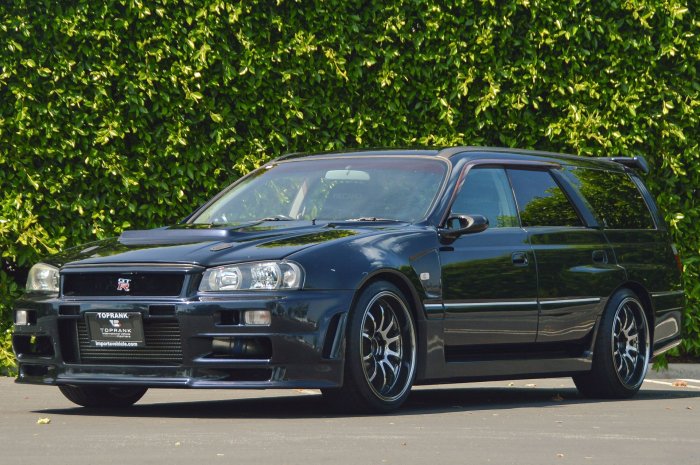
The 1998 Nissan Stagea, a wagon that blurred the lines between practicality and performance, possessed a unique design that set it apart from its contemporaries. Its exterior styling combined elements of sportiness and functionality, while the interior offered a blend of comfort and driver-focused ergonomics.
Exterior Design
The Stagea’s exterior design reflected its dual nature as both a spacious wagon and a performance-oriented vehicle. Its distinctive features included a sloping roofline, a wide, low stance, and a muscular front fascia. The front grille, with its large Nissan badge and horizontal chrome bars, emphasized the car’s aggressive nature.
The headlights, with their angular design, added to the Stagea’s sharp and sporty look. The side profile showcased the car’s flowing lines, with the sculpted wheel arches highlighting the presence of larger wheels and tires. The rear end featured a distinctive taillight design, with vertical LED lights that extended into the rear bumper.
Interior Design
The interior of the 1998 Nissan Stagea was designed to provide a comfortable and functional environment for both driver and passengers. The materials used were of high quality, with soft-touch plastics and leather upholstery available on higher trim levels. The dashboard was driver-oriented, with all the essential controls within easy reach.
The seats were supportive and comfortable, with ample legroom and headroom for both front and rear passengers. The Stagea offered a variety of features, including power windows and locks, air conditioning, and a premium audio system. Higher trim levels were equipped with a sunroof, leather seats, and a navigation system.
Key Dimensions and Specifications, 1998 Nissan Stagea
The following table provides key dimensions and specifications of the 1998 Nissan Stagea:| Specification | Value ||—|—|| Length | 4,695 mm || Width | 1,720 mm || Height | 1,470 mm || Wheelbase | 2,725 mm || Curb Weight | 1,500 kg
1,600 kg (depending on trim level) |
| Engine | 2.5L RB25DET (turbocharged) || Transmission | 5-speed manual or 4-speed automatic || Power | 280 PS (206 kW) || Torque | 363 Nm || Fuel Economy | 10.0 km/L (combined) |
Driving Experience: 1998 Nissan Stagea
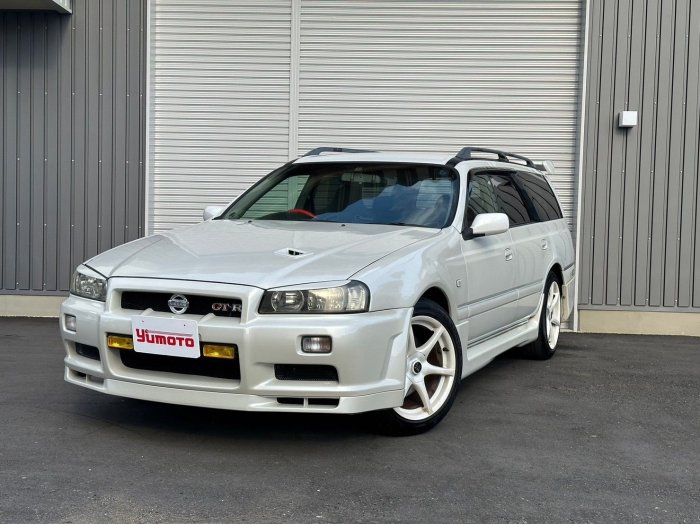
The 1998 Nissan Stagea, with its blend of performance and practicality, offers a unique driving experience that sets it apart from conventional station wagons. It’s not just about getting from point A to point B; it’s about enjoying the journey with a touch of sportiness and versatility.
The 1998 Nissan Stagea, with its sporty design and powerful engine, is a highly sought-after car among enthusiasts. While not as widely recognized as some of the more traditional classic cars , the Stagea has earned its place in the hearts of car lovers with its unique blend of performance and practicality.
Its distinctive features, like the integrated rear spoiler and aggressive front fascia, make it stand out from the crowd, further solidifying its status as a coveted classic in its own right.
Handling and Ride Quality
The Stagea’s handling is a testament to Nissan’s engineering prowess. The car’s responsive steering and well-balanced suspension allow for precise control and confident maneuvering, whether you’re navigating tight city streets or tackling winding mountain roads. The suspension, tuned for a sporty yet comfortable ride, effectively absorbs bumps and imperfections, providing a smooth and enjoyable ride even on rough surfaces.
Driving Dynamics
The 1998 Nissan Stagea is available with a range of engine options, each offering its own unique driving experience. The naturally aspirated RB25DET engine, with its 2.5-liter displacement and turbocharger, delivers impressive power and torque, providing a thrilling acceleration experience.
The Stagea’s rear-wheel-drive layout further enhances its driving dynamics, offering a more engaging and responsive driving experience compared to front-wheel-drive vehicles.
“The Stagea’s handling is a joy to experience. It feels planted and composed even at high speeds, making it a pleasure to drive on winding roads.”
A satisfied Stagea owner.
Safety Features and Technology
The 1998 Nissan Stagea, despite being a performance-oriented wagon, prioritized safety and offered a range of features that were considered advanced for its time. These features aimed to provide occupants with a secure and comfortable driving experience, keeping them safe in various driving scenarios.
Safety Features
The 1998 Nissan Stagea came equipped with a comprehensive suite of safety features designed to protect occupants in the event of a collision. These features included:
- Dual Front Airbags:The Stagea was equipped with dual front airbags, a standard safety feature that was becoming increasingly common in vehicles during this era. These airbags helped to cushion the impact of a collision and reduce the risk of serious injuries to the driver and front passenger.
- Anti-lock Braking System (ABS):ABS was another standard feature in the 1998 Stagea. ABS prevents the wheels from locking up during hard braking, allowing the driver to maintain steering control and avoid skidding. This system significantly improved the vehicle’s braking performance and overall safety, especially in emergency situations.
- Electronic Brakeforce Distribution (EBD):EBD, a system that automatically distributes brake force to each wheel based on load and conditions, was also included in the Stagea. This ensured optimal braking performance and stability, particularly when braking under uneven load conditions.
- Seat Belts:The Stagea came equipped with three-point seat belts for all seating positions. These belts, along with the airbags, helped to secure occupants in their seats during a collision, reducing the risk of injury.
- Child Safety Locks:The rear doors were equipped with child safety locks, preventing children from opening the doors while the vehicle was in motion. This feature ensured the safety of young passengers by preventing them from accidentally opening the doors and potentially falling out.
Technological Advancements
While the 1998 Nissan Stagea didn’t boast the same level of advanced technology found in modern vehicles, it did offer some notable features for its time:
- Navigation System:Some models of the Stagea were equipped with an optional navigation system. This system, while not as sophisticated as modern GPS systems, provided basic route guidance and helped drivers find their way around unfamiliar areas.
- Audio System:The Stagea came standard with an AM/FM radio cassette player. Some models also offered an optional CD player, providing occupants with a range of entertainment options during their drives.
- Power Windows and Mirrors:The Stagea featured power windows and mirrors, adding convenience and comfort to the driving experience. These features were considered standard in many vehicles during this era, and they enhanced the overall user-friendliness of the car.
Comparison with Contemporaries
In terms of safety features, the 1998 Nissan Stagea was comparable to its contemporaries in the mid-size wagon segment. Many vehicles offered similar safety features like dual front airbags, ABS, and EBD. However, the Stagea’s emphasis on performance might have led to some competitors offering more advanced safety features like side airbags or traction control, which were still emerging technologies at the time.Regarding technology, the Stagea’s offerings were in line with its contemporaries.
Most vehicles in this segment featured basic audio systems, power windows, and mirrors. The availability of a navigation system was a more advanced feature, and it was not as widely available in this class as it is today.
Reliability and Maintenance
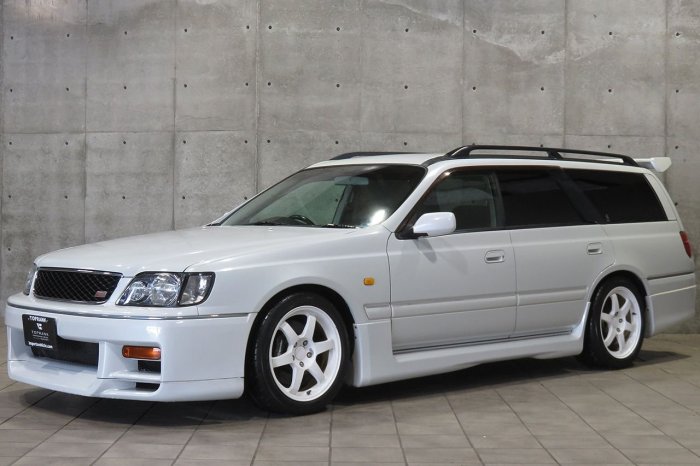
The 1998 Nissan Stagea, known for its performance and versatility, generally enjoys a solid reputation for reliability. However, like any vehicle, it requires regular maintenance and attention to address potential issues. This section delves into the reliability aspects of the 1998 Stagea, providing insights into common maintenance needs and potential problems.
Common Maintenance Needs and Potential Issues
Understanding common maintenance needs and potential issues associated with the 1998 Nissan Stagea is crucial for ensuring its longevity and optimal performance. Regular maintenance and timely addressing of potential issues can help prevent costly repairs and ensure a smooth driving experience.
Engine and Drivetrain
- Engine Oil Changes:Regular oil changes are essential for maintaining engine health. The manufacturer recommends oil changes every 5,000 miles or six months, whichever comes first. Using the correct type of oil and filter is crucial for optimal engine performance.
- Timing Belt Replacement:The timing belt is a critical component responsible for synchronizing the engine’s valves and pistons. Replacing the timing belt at the recommended intervals (typically around 60,000 to 100,000 miles) is essential to prevent catastrophic engine damage.
- Transmission Fluid:Regular transmission fluid changes are vital for smooth shifting and longevity. The manufacturer’s recommended interval for transmission fluid changes is typically around 30,000 to 60,000 miles.
- Spark Plugs:Worn spark plugs can lead to poor engine performance, fuel economy issues, and misfires. Replacing spark plugs at the recommended intervals (typically around 30,000 to 100,000 miles) is crucial for optimal engine operation.
- Fuel Filter:The fuel filter prevents debris from entering the fuel system. Replacing the fuel filter at the recommended intervals (typically around 30,000 to 60,000 miles) is essential for smooth fuel flow and engine performance.
Suspension and Brakes
- Suspension Components:The Stagea’s suspension system is designed for performance and handling. Regular inspection and replacement of worn components such as shock absorbers, struts, and control arm bushings are essential for maintaining a smooth and safe ride.
- Brake Pads and Rotors:Brake pads wear down over time, and rotors can become grooved or warped. Regular inspection and replacement of worn brake components are crucial for safe braking performance.
Electrical System
- Battery:The battery is a critical component for starting the engine and powering the electrical system. Replacing the battery when it shows signs of weakness or age is essential for reliable operation.
- Alternator:The alternator generates electricity to charge the battery and power the electrical system. Regular inspection and replacement of a faulty alternator are crucial for preventing electrical problems.
- Starter:The starter motor engages the engine to start it. Replacing a faulty starter is essential for ensuring the vehicle can be started.
Body and Interior
- Rust Prevention:The Stagea’s body panels are susceptible to rust, especially in areas with harsh weather conditions. Regular inspection and application of rust-proofing treatments can help prevent rust formation.
- Interior Trim:The interior trim can wear down over time, especially the seats, carpets, and dashboard. Regular cleaning and maintenance can help preserve the interior’s appearance and comfort.
Tips for Maintaining the 1998 Nissan Stagea in Optimal Condition
- Follow the Manufacturer’s Maintenance Schedule:The owner’s manual provides a detailed maintenance schedule that Artikels recommended service intervals for various components. Following this schedule is essential for preventing major issues and ensuring the vehicle’s longevity.
- Use High-Quality Parts and Fluids:Using high-quality parts and fluids is essential for maintaining optimal performance and reliability. Avoid using cheap aftermarket parts, as they may not meet the same standards as OEM parts.
- Regular Inspections:Regular inspections by a qualified mechanic can help identify potential problems before they become major issues. Schedule regular inspections, especially after long trips or when the vehicle starts to exhibit unusual noises or behaviors.
- Address Problems Promptly:Ignoring small problems can lead to larger, more expensive repairs down the line. Address any issues promptly, whether it’s a minor leak, a strange noise, or a warning light on the dashboard.
- Store the Vehicle Properly:Storing the vehicle properly when not in use can help prevent damage and premature wear. Park the vehicle in a dry, covered area, and consider using a battery tender to maintain battery charge.
Legacy and Cultural Impact
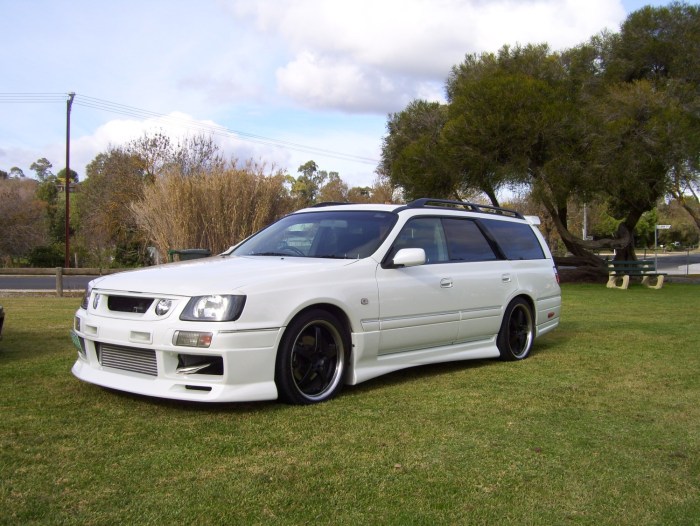
The 1998 Nissan Stagea, despite its relatively short production run, has left an indelible mark on automotive culture, particularly in Japan and other parts of Asia. Its unique blend of practicality, performance, and distinctive styling has garnered a dedicated following and solidified its status as a sought-after classic.
Popularity and Cultural Significance
The Stagea’s popularity can be attributed to several factors. Its spacious interior, versatile wagon body style, and powerful engine options made it an attractive choice for families and enthusiasts alike. In Japan, the Stagea was particularly popular among young professionals and car enthusiasts, who appreciated its sporty handling and unique aesthetic.
Its association with the “JDM” (Japanese Domestic Market) culture further amplified its appeal, particularly among international car enthusiasts.
Enduring Legacy and Collector’s Status
The Stagea’s enduring legacy is a testament to its distinctive character and performance capabilities. Its unique design, featuring a sleek and aerodynamic profile, coupled with its powerful engine options, has made it a desirable collectible among car enthusiasts. The Stagea’s popularity has also been fueled by its relatively low production numbers, which have contributed to its rarity and desirability in the collector car market.
Media and Pop Culture Appearances
The 1998 Nissan Stagea has made appearances in various forms of media, further solidifying its cultural impact. Notably, it has been featured in several video games, including the popular “Gran Turismo” series, where its performance and handling characteristics have been praised.
The Stagea’s distinctive styling and sporty appeal have also made it a popular choice for use in movies and television shows, further contributing to its cultural recognition.
Last Word
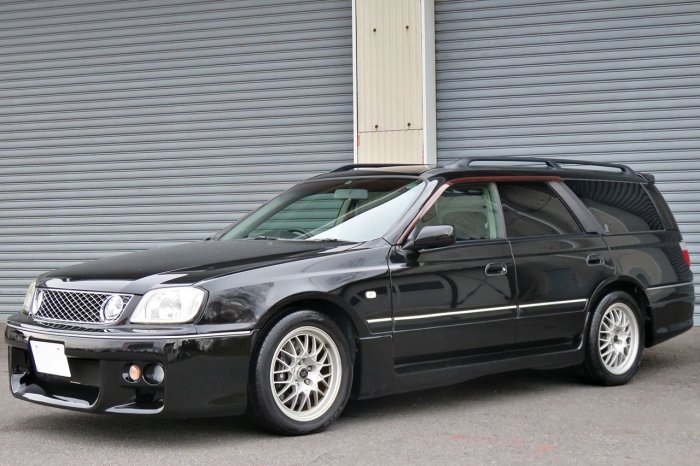
The 1998 Nissan Stagea stands as a testament to Japanese automotive ingenuity, a vehicle that seamlessly blended performance, practicality, and distinctive style. Its legacy continues to resonate with enthusiasts, serving as a reminder of a time when wagons were more than just family haulers.
Whether cruising the open road or navigating urban streets, the Stagea offered a unique driving experience, leaving an indelible mark on the automotive landscape.